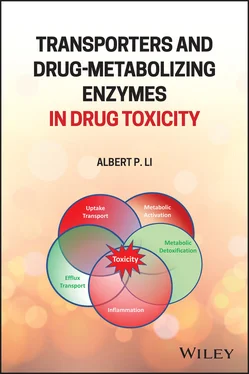Terfenadine was marketed in 1985 in the United States as the first nonsedating antihistamine for the treatment of seasonal allergic rhinnitis. It was available as an OTC drug and was found to be associated with lethal cases of torsades de pointes, a form of ventricular arrythmia, in patients who were also taking macrolide antibiotics such as erythromycin [183–185], and the antifungal ketoconazole [184,186–188], and in patients with compromised liver functions [189]. A black box warning for terfenadine was issued by FDA in 1992 and the drug was eventually removed from the market in 1997. Terfeanadine was replaced by fexofenadine, the pharmacologically active metabolite of terfenadine without cardiotoxicity [190].
3.11.1 Drug Metabolism and Toxicity
The legacy of terfenadine drug interactions: Drug interactions with terfenadine have historical significance. It was the first clear indication that a P450 inhibiting perpetrator drug could increase the plasma concentration of a coadministered victim drug that is a substrate of the inhibited P450 isoform, resulting in toxicity. As a result, US FDA published the first drug–drug interaction guidance document proposing a mechanistic‐based approach to identify perpetrator and victim drugs of drug–drug interactions. A major advance catalyzed by FDA’s proposed strategy is the recognition of species differences in drug metabolism. The FDA 1997 guidance document proposed that before approval for marketing, a drug needs to be investigated using in vitro human drug metabolizing enzyme‐containing systems, with focus on human P450 isoforms, on whether its metabolism can be affected by the existing drugs that are inhibitors or inducers of drug metabolism, as well as the drug’s potential to inhibit or induce drug metabolism of P450 isoforms that are responsible for the metabolism of marketed drugs [191]. The recommended in vitro human hepatic metabolic systems include human liver microsomes, cDNA‐expressed P450 isoforms, and human hepatocytes [192]. This strategy is now globally recognized by international regulatory agencies for drug approval, has been continuously been improved, with the most recent US FDA guidance involving also uptake and efflux drug transporters [193]. The validity of this new approach is supported by known clinical cases of drug–drug interactions based on transporter activities [194].
Terfenadine metabolism and toxicity: Terfenadine causes prolongation of the QT interval due to suppression of specific delayed rectifier ventricular K+ currents as a result of the blockade of the hERG‐IKr channel [195–198]. The lack of cardiotoxicity in patients administered terfenadine alone is a result of its rapid metabolic clearance at the therapeutic dose, as clearly demonstrated in a clinical study where detectable unmetabolized terfenadine was only observed in patients coadministered ketoconazole, and not in patients administered only terfenadine [187]. CYP3A4 is the major P450 isoform responsible for the metabolic clearance of terfenadine, resulting in hydroxy‐terfenadine which is further oxidized to fexofenadine, the carboxylic acid metabolite of terfenadine.
3.11.2 Transporter and Toxicity
Results of an in vitro study with Caco2 cells show that terfenadine is a substrate of Pgp. The authors suggest that inhibition of intestinal Pgp efflux transport (e.g. by ketoconazole) may contribute to a higher plasma concentration [199]. This suggestion is not yet substantiated by clinical findings.
The major risk factor associated with terfenadine cardiotoxicity is its coadministration with drugs that are potent inhibitors of CYP3A4 such as ketoconazole, fluconazole, itraconazole, erythromycin, clarithromycin, cimetidine, and troleandomycin [200–204]. Patients with low CYP3A4 activities due to genetic polymorphism or liver diseases may also be at high risk due to lower hepatic clearance of terfenadine [189]. There is evidence that grapefruit juice, a known inhibitor of intestinal CYP3A4 and the enteric efflux transporter Ppg, would increase plasma terfenadine concentration to detectable levels with QT prolongation effects [205–208]. The clinical significance of the grapefruit juice effects is yet to be substantiated.
3.12 Troglitazone (Rezulin®)
Troglitazone (2,4‐thiazolidinedione) was the first peroxisome proliferator‐activated receptor (PPAR) antagonist insulin sensitizer developed for the treatment of type 2 diabetes. It received FDA approval for marketing in 1997, and was withdrawn from the market in 2000 after reports of at least 12 cases of severe liver injuries [209], leading to deaths or a need for liver transplantation [209–211]. Troglitazone was one of the first drugs associated with idiosyncratic hepatotoxicity [212] generally classified as drugs with severe hepatotoxicity at a low incidence than cannot be readily detected in regulatory clinical trials. The reported incidences are 14 [213] and 19 [214] per 100 000 patients. Upon introduction of troglitazone to the market in March 1997 to its market withdrawal in March 2000, 83 cases of liver failure were reported with an estimated exposed population of 1.92 million [215]. Signs of troglitazone hepatotoxicity were observed during prospective clinical trials, with 1.9% of the patients exhibiting signs of liver injuries, leading to a recommendation of frequent monitoring of liver enzyme chemistries for the administered patients before the official withdrawal of the drug from the market [209]. Liver enzyme elevation would resolve with or without stoppage of drug administration. Routine monitoring of liver enzymes, however, did not prevent the onset of troglitazone‐induced liver failures [215].
3.12.1 Drug Metabolism and Toxicity
As one of the first drugs associated with liver failures, extensive research has been performed with troglitazone to elucidate the key events associated with its toxicity. Investigations with human liver microsomes, recombinant P450s, and human hepatocytes show that troglitazone is metabolized by P450, especially CYP3A4, to highly reactive o ‐quinone methide and quinone epoxide metabolites that form conjugates with GSH and N ‐acetylcysteine [216, 217]. Troglitazone is also found to be metabolized to glucuronide and sulfate conjugates [218]. In vitro studies with human hepatocytes suggest that the parent drug is responsible for the cytotoxicity of troglitazone, with conjugative pathways as detoxifying [219]. Reviews of troglitazone hepatotoxicity have suggested that reactive metabolite formation is not likely to be responsible for its hepatocellular cytotoxicity [220, 221]. Reactive metabolites and the associated oxidative stress [121, 222, 223] and cytotoxic inflammatory responses to metabolite‐protein conjugates are believed to be key events leading to hepatic failure [24, 224, 225].
3.12.2 Transporter and Toxicity
Troglitazone represents one of the first hepatotoxic drugs where the accumulation of intracellular bile salts to cytotoxic levels due to BSEP inhibition is a likely mechanism of its toxicity. The initial discovery of troglitazone‐mediated BSEP inhibition was observed in rats in vivo and in rat liver plasma membrane preparations. Troglitazone was found to induce cholestasis in male and female rats. Troglitazone was found to inhibit BSEP‐mediated taurocholate transport with an apparent K ( i ) value, 1.3 μM, while its conjugated metabolite, troglitazone sulfate, was a more potent inhibitor, with an apparent K ( i ) value of 0.23 μM [226, 227].
Читать дальше












